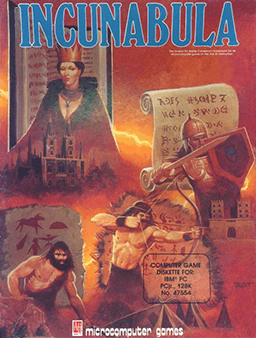Incunabula (video game)
| Incunabula | |
|---|---|
 | |
| Developer(s) | Avalon Hill |
| Publisher(s) | Avalon Hill |
| Designer(s) | Steve Estvanik |
| Series | Civilization |
| Platform(s) | DOS |
| Release date(s) | 1984 |
| Genre(s) | 4X |
Incunabula is a 1984 computer game by Avalon Hill. It was designed by Steve Estvanik. It is the original computerized version of Avalon Hill's Civilization board game. It was eclipsed by Sid Meier's much more successful Civilization, and its following series, released in 1991.
Gameplay
The gameplay loosely follows the rules of Avalon Hill's Civilization board game. It consists of three type of "scenarios", Incunabula, Imperium, and Traders. Incunabula resembles the board game most. One to three players can play and the computer players can be randomly assigned basis of law and "personality". The personalities determine how likely a computer opponent is to attack you. Personalities are:
- Choleric
- Phlematic
- Melancholic
- Sanguine
The choices for basis of law are:
- Theocracy
- Oligarchy
- Utopia
- Khanate
Combat follows Civilization rules with a one for one unit loss. There are no technologies to obtain but each player's progress is tracked through phases such as clan and tribe. The game is won on the basis of accumulating trade.
The different laws and personalities, and random starting positions, are the only game variations. There is only one map, and no varying difficulty level.[1]
Reception
Jerry Pournelle in 1985 reported that Avalon Hill's Incunabula and By Fire and Sword "snaffled off more of my time than I could afford".[2] Computer Gaming World that year noted the resemblance to Avalon Hill's Civilization board game and wondered why the company did not call the video game Computer Civilization, and cautioned that because of the lack of map variations or difficulty levels, "the probable solitaire life of the game could be rather limited". It nonetheless concluded, "Incunabula is an interesting and enjoyable multi-player game. The combination of combat, good trading, and diplomacy will give a wide variety of gamers something worth a closer look".[1] In 1990 and 1993 the magazine gave the game three stars out of five.[3][4]
References
- 1 2 MacKames, Stewart (November–December 1985). "Incunabula". Computer Gaming World. 5 (5). p. 63. Retrieved 21 May 2016.
- ↑ Pournelle, Jerry (September 1985). "PCs, Peripherals, Programs, and People". BYTE. p. 347. Retrieved 20 March 2016.
- ↑ Brooks, M. Evan (October 1990). "Computer Strategy and Wargames: Pre-20th Century". Computer Gaming World. p. 11. Retrieved 16 November 2013.
- ↑ Brooks, M. Evan (June 1993). "An Annotated Listing of Pre-20th Century Wargames". Computer Gaming World. p. 136. Retrieved 7 July 2014.